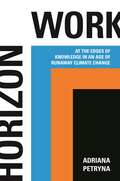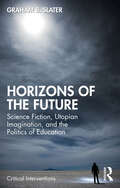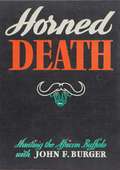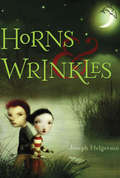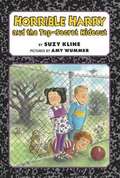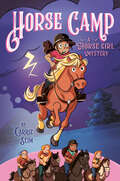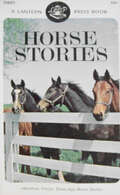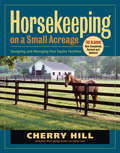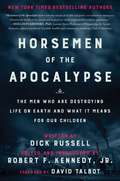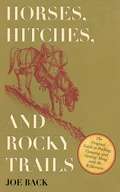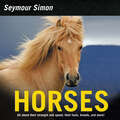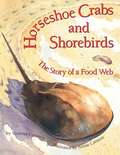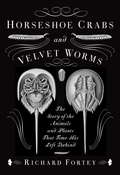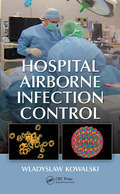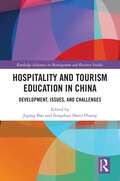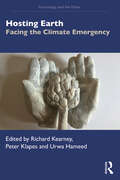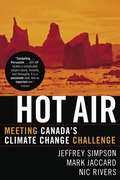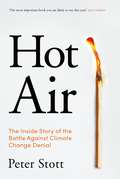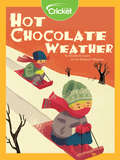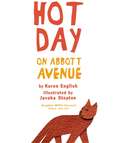- Table View
- List View
Horizon Work: At the Edges of Knowledge in an Age of Runaway Climate Change
by Adriana PetrynaA new way of thinking about the climate crisis as an exercise in delimiting knowable, and habitable, worldsAs carbon dioxide emissions continue to rise, Earth’s fragile ecosystems are growing increasingly unstable and unpredictable. Horizon Work explores how climate change is disrupting our fundamental ability to project how the environment will act over time, and how these rapidly faltering predictions are colliding with the dangerous new realities of emergency response.Anthropologist Adriana Petryna examines the climate crisis through the lens of “horizoning,” a mode of reckoning that considers unnatural disasters against a horizon of expectation in which people and societies can act. She talks to wildfire scientists who, amid chaotic fire seasons and shifting fire behaviors, are revising predictive models calibrated to conditions that no longer exist. Petryna tells the stories of wildland firefighters who could once rely on memory of previous fires to gauge the behaviors of the next. Trust in patterns has become an occupational hazard. Sometimes, the very concept of projection becomes untenable. Yet if all we see is doom, we will overlook something crucial about the scientific and ethical labor needed to hold back climate chaos. Here is where the work of horizoning begins.From experiments probing our planetary points of no return to disaster ecologies where the stark realities of climate change are being confronted, Horizon Work reveals how this new way of thinking has the power to reverse harmful legacies while turning voids where projection falters into spaces of collective action and recoverable futures.
Horizons of the Future: Science Fiction, Utopian Imagination, and the Politics of Education (Critical Interventions)
by Graham B. SlaterHorizons of the Future: Science Fiction, Utopian Imagination, and the Politics of Education examines the relationship between science fiction, education, and social change in the 21st century.Global capitalism is ecologically unsustainable and ethically indefensible; time is running out to alter the course of history if humanity is to have hope of a livable future beyond the next century. However, alternatives are possible, offering much more equality, care, justice, joy, and hope than the established order. Popular culture and schools are key sites of struggles to imagine such alternatives. Drawing on critical theory, cultural studies, and sociology, Slater articulates the promising connection between science fiction and the future of education. He offers cutting-edge engagement with themes, perspectives, and modes of imagination in science fiction that can be mobilized politically and pedagogically to envision and enact critical forms of education that cultivate new utopian ways of relating to self, society, and the future.This thought-provoking book will be of interest to scholars and students in the social sciences and education.
Hormigas (¡Arriba la Lectura!, Level I #62)
by Elsie NelleyLas hormigas son insectos muy pequeños, pero muy trabajadores. Aprende cómo viven y por dónde andan. NIMAC-sourced textbook
Hornbills (Nature's Children)
by Lorien KiteHow many different kinds of hornbills are there? How big is a hornbill? Where do hornbills live? Find the answers to these questions, and learn much more about the physical characteristics, behavior, habitat, and lives of hornbills.
Horned Death
by Ellis Christian Lenz John F. BurgerOriginally published in 1947, this book is considered one of the best ever written on hunting the African buffalo.“John F. Burger, Afrikander and author of this book, would heartily endorse any theatrical effort to simulate the charge of an African bull buffalo—if no human life is to be risked. This notable professional hunter, who is here being introduced to the American public, has miraculously survived to live and tell of many last-ditch encounters with the powerful and crafty buffalo. Mr. Burger’s experiences in the game fields of his native continent cover a period of forty years, and in that time more than one thousand of the massive brutes have fallen to his rifles. As he takes care to explain, only a small number of the animals in that record bag have actually charged; but in that temperate statement there rests proof of his usual success in placing a first, effective hit—the shot that renders a charge improbable. Failure of that first shot, or the effect of factors beyond the hunter’s control, constitutes the explosive cap that can set this specimen of black dynamite into action. Once the buffalo’s charge is actually under way his only objective is to produce a dead hunter. The animal has accomplished his grim purpose in many instances. Too frequently the gored and trampled victim has been a veteran of the trails, not a novice hunter or a defenseless native. In some vitally unaccountable way the buffalo had gained advantages at a rate faster than was allowed the hunter. The man was then denied that last precious asset for survival, luck. Our author lives to tell of his close encounters with the horned death simply because luck never failed to tip the scales in his favor.”
Horns and Wrinkles
by Nicoletta Ceccoli Joseph HelgersonHow can you tell if a river's under a spell? River trolls, rock trolls, blue-wing fairies-the usual suspects. The stretch of the Mississippi where Claire lives has rumors of them all, not that she's ever spotted any. But then Claire's cousin Duke takes a swim and sprouts a horn-a long, pointy, handsome thing. After that, Claire doesn't have much choice but to believe that something rivery is going on, especially since she's the only one who can help Duke lose his new addition.
Horrible Harry and the Top-Secret Hideout (Horrible Harry #37)
by Suzy Kline Amy WummerA story about appreciating and preserving the environment in your own backyard.Doug thought he knew everything about his best friend, Harry . . . until he discovers that Harry has a secret hideout in the woods just outside of South School.Unfortunately, Harry can't keep his hideout a secret much longer, because the land is going to be sold and turned into a big apartment building--unless he and the rest of the kids in Room 3B can save it. Harry has the idea to turn the lot into a nature center, and his friends want to help after he shows them the beautiful wildflowers, yellow spotted salamanders, and slimy tadpoles. But can Harry persuade the school board to agree, too? Or will his horrible fear come true: losing his hideout forever?
Horrid Henry's Sizzling Summer
by Tony Ross Francesca SimonHave a sizzling summer with this totally awesome collection of six favourite Horrid Henry summer stories. Join Henry for a super summer holiday as he raids the Secret Club tent, gives Aerobic Al a run for his money on sports day, causes chaos on his first TV appearance, goes on a less-than awesome camping trip and much more.The perfect summer holiday read for Horrid Henry fans everywhere.
Horse Breeds of North America: The Pocket Guide to 96 Essential Breeds
by Judith DutsonAn amazing variety of horse breeds roam North America’s vast and geographically diverse landscape. This detailed portable handbook celebrates the unique qualities of 96 regional breeds, from the sleek muscles of racing thoroughbreds and the stoic power of draft horses to the easy gait of pleasure horses at your local farm. Fascinating facts about each horse breed’s size, talents, and suitability for various types of work are accompanied by full-color photographs in this fun and informative reference guide.
Horse Camp: A Horse Girl Mystery (Horse Girl)
by Carrie SeimYEE-HAW! Willa is back in this standalone sequel to Horse Girl. This time, she tackles summer camp, new and old frenemies, and worst yet: a horse that's mysteriously gone missing.Seventh-grader Willa is head-over-hooves when she finds a secret note inviting her to Juniper Ranch—a sleepaway camp that&’s all about horses. The camp promises trail rides, horseback swims, and &“ghorst&” stories, plus tons of new horse-girl and (gasp!) horse-boy friends. Even better? Willa&’s pals from Oakwood Riding Academy—including her sworn frenemy, Amara—are all coming along for the fun.But when Willa makes a dangerous mistake and a beloved steed goes missing, everyone at Juniper Ranch is suddenly a suspect. Wills isn&’t sure who to trust (including herself) as she tries to figure out who&’s behind the mysterious horsenapping. And where they might be lurking. And just how she&’ll save her &“forever herd&” before a frightening storm rolls into camp. Gulp!
Horse Racing's Holy Grail: The Epic Quest For The Kentucky Derby
by Steve HaskinInterlaced with humor, this book looks at the pitfalls and pressures owners, trainers, and jockeys face at Derby time and why most fail, while others, notably the "big three" of D. Wayne Lukas, Bob Baffert, and Nick Zito, always seem to win the big prize.
Horse Stories
by David ThomasEditor David Thomas has selected over a dozen stories for those who love horses. Some of the stories are set in wild country, some in small towns, some in cities. There’s the wild black stallion no man had ever been able to tame, and Two-bits, the policeman’s horse who helped catch a criminal. There’s Torchy, the pony Mary wanted so badly— except that she didn’t have the ten dollars needed to buy him. There’s Ba-ee, the orphan colt found by a crippled Indian boy—and Nemmy, the most difficult horse in Battery B. Written by famous authors such as Jim Kjelgaard, Irving Crump, Harry Sinclair Drago, Kathryn Cook, and Matt Armstrong, among others, these exciting stories will bring a tear to your eyes, a lump to your throat, and joy to your heart.
Horsekeeping on a Small Acreage: Designing and Managing Your Equine Facilities
by Cherry HillKeeping your own horses requires dedication, hard work, and a sincere interest in the well-being of your animals. This practical guide shows you how to design efficient facilities and establish effective maintenance routines so that your horses can stay happy, healthy, and safe on even the smallest plots of land. Offering expert advice on barn designs, fencing options, and pasture management, Cherry Hill stresses the importance of understanding horse behavior and environmentally responsible land stewardship as integral aspects of a pleasurable and rewarding horsekeeping experience.
Horsemen of the Apocalypse: The Men Who Are Destroying the Planet—And How They Explain Themselves to Their Own Children
by David Talbot Dick Russell Robert F. Kennedy Jr.The science is overwhelming; the facts are in. The planet is heating up at an alarming rate and the results are everywhere to be seen. Yet, as time runs out, climate progress is blocked by the men who are profiting from the burning of the planet: energy moguls like the Koch brothers and Exxon Mobil CEO Rex Tillerson. Powerful politicians like Senators Mitch McConnell and Jim Inhofe, who receive massive contributions from the oil and coal industries. Most of these men are too intelligent to truly believe that climate change is not a growing crisis. And yet they have put their profits and careers ahead of the health and welfare of the world’s population?and even their own children and grandchildren. How do they explain themselves to their offspring, to the next generations that must deal with the environmental havoc that these men have wreaked? Horsemen of the Apocalypse takes a personal look at this global crisis, literally bringing it home.
Horses, Hitches, and Rocky Trails
by Joe BackHorses, Hitches, and Rocky Trails is the most complete presentation available of the method of packing for the wilderness. The full treatment is amplified by the brilliant drawings by Joe Back, a most-able artist, as well as a man who knows what he is talking about from personal experience. Black includes step-by-step instructions on not only how to prepare for heading out into the wilderness, but also how to cope with the elements. Some of the lessons taught in this book include:Packing horsesEquipmentBalancing the loadMaking campGetting along in the wildernessFinal tiesAnd many more!Horses, Hitches, and Rocky Trails is for both the amateur just learning how to prepare for the wilderness and the professional packer looking for some new tips. With wonderful illustrations, Joe Back makes it easy to be prepared and safe on your travels. So whether this is your first time out or you're a seasoned veteran, make sure that Horses, Hitches, and Rocky Trails is included with the rest of your packed equipment.
Horses: Revised Edition
by Seymour SimonFrom award-winning science writer Seymour Simon comes a completely revised and updated edition of Horses, with brand-new full-color photographs. This nonfiction picture book is an excellent choice to share during homeschooling, in particular for children ages 6 to 8. It’s a fun way to learn to read and as a supplement for activity books for children.Readers will learn how horses came to be domesticated, how to distinguish different breeds, the important roles horses have served throughout history, and more. From stallions and mares and Clydesdales to Palominos, this is sure to be a hit with horse lovers and animal lovers everywhere!This updated edition includes:• author’s note• stunning full-color photographs• glossary• index• additional reading sourcesSupports the Common Core Learning Standards, Next Generation Science Standards and the Science, Technology, Engineering, and Math (STEM) standards.
Horseshoe Crabs And Shorebirds: The Story Of A Foodweb
by Victoria Crenson Annie CannonEach spring, hundreds of thousands of horseshoe crabs crawl from the bottom of Delaware Bay to lay billions of pearly green eggs on the beaches. Their salty eggs provide a feast for scavenging coastal animals, but billions more are eaten by the flocks of shorebirds that stop to rest and feed each spring after flying north from their homes in South America. In recent years the horseshoe crab population has dwindled. In turn, the number of shorebirds that fly north each year has grown smaller. Illuminated with warm, detailed watercolors, Horseshoe Crabs and Shorebirds demonstrates the delicate relationship between these animals and is an excellent resource for ecology lessons, as well as a dramatic storybook for sharing.
Horseshoe Crabs and Velvet Worms
by Richard ForteyFrom one of the world's leading natural scientists and the acclaimed author of Trilobite!, Life: A Natural History of Four Billion Years of Life on Earth and Dry Storeroom No. 1 comes a fascinating chronicle of life's history told not through the fossil record but through the stories of organisms that have survived, almost unchanged, throughout time. Evolution, it seems, has not completely obliterated its tracks as more advanced organisms have evolved; the history of life on earth is far older--and odder--than many of us realize. Scattered across the globe, these remarkable plants and animals continue to mark seminal events in geological time. From a moonlit beach in Delaware, where the hardy horseshoe crab shuffles its way to a frenzy of mass mating just as it did 450 million years ago, to the dense rainforests of New Zealand, where the elusive, unprepossessing velvet worm has burrowed deep into rotting timber since before the breakup of the ancient supercontinent, to a stretch of Australian coastline with stromatolite formations that bear witness to the Precambrian dawn, the existence of these survivors offers us a tantalizing glimpse of pivotal points in evolutionary history. These are not "living fossils" but rather a handful of tenacious creatures of days long gone. Written in buoyant, sparkling prose, Horseshoe Crabs and Velvet Worms is a marvelously captivating exploration of the world's old-timers combining the very best of science writing with an explorer's sense of adventure and wonder.
Hospital Airborne Infection Control
by Wladyslaw KowalskiAlthough nosocomial, or hospital-acquired, infections have been well cataloged and are fairly well understood, traditional solutions have failed to completely eliminate the problem. Even the most modern hospitals find themselves stymied by the persistence of these pathogens in hospital wards and operating rooms. The degree to which most of these in
Hospitality and Tourism Education in China: Development, Issues, and Challenges (Routledge Advances in Management and Business Studies)
by Jigang BaoThis book is the first to systematically introduce China’s tourism education system and the various tourism education practices in China to the international audience and stakeholders. China has the world’s largest tourism education system, which consists of over 1,000 higher learning institutions with tourism-related programs and over half a million of tertiary-level students studying in these programs. Despite the industry scale, internationally, little is known about this tourism education system and how it operates. Knowledge and better understanding of China’s tourism education system are important as tourism becomes one of the critical forces transforming economy, society and environment. The book offers an historical evaluation of China tourism education development and elaborates on the current industry status and practices in different subject fields of China’s tourism education, including tourism management, hospitality management, events and festival management in higher education, tourism vocational education, tour guides training and certification, master of tourism administration (MTA) education as a unique education model in China, PhD education in tourism, tourism curriculum, research and international collaboration in tourism education in China. The book provides relevant knowledge to international tourism education providers, industry practitioners, human resource managers, government officials, and tourism academics, researchers, and students.
Hosting Earth: Facing the Climate Emergency (Psychology and the Other)
by Richard Kearney Peter Klapes Urwa HameedHosting Earth is a timely and much-needed volume in the emerging literature of environmental philosophy, drawing upon art, science, and politics to explore alternatives to the traditional domination of nature by humans.Featuring a dialogue with Mary Robinson (former UN High Commissioner for Human Rights and former President of Ireland), which addresses the current climate emergency, this book engages the question of ecological hospitality: what does it mean to be guests of the earth as well as hosts? It includes chapters by cutting-edge scholars in the philosophy of nature, as well as artists, scientists, psychologists, and theologians. The contributors discuss proposals for a new "Poetics of the Earth," opening horizons beyond our perilous Anthropocene to a new Symbiocene of mutual collaboration between human and non-human species.Focusing on the central role that the human psyche plays in answering our current ecological emergency, Hosting Earth is for anybody invested in the future of our planet and how psychological, psychoanalytic, and philosophical thought can reorient the current conversation about ecology.
Hot Air: Meeting Canada's Climate Change Challenge
by Jeffrey Simpson Nic Rivers Mark JaccardHere's a clear, believable book for Canadians concerned about our situation -- and it offers a solution. It's a brilliant mix. To "Canada's best mind on the environment," Mark Jaccard, who won the 2006 Donner Prize for an academic book in this area, you add Nic Rivers, a researcher who works with him at Simon Fraser University. Then you add Jeffrey Simpson, the highly respected Globe and Mail columnist, to punch the message home in a clear, hard-hitting way. The result is a unique book.Most other books on energy and climate change are: (a) terrifying or (b) academic or (c) quirky, advocating a single, neat solution like solar or wind power. This book is different. It starts with an alarming description of the climate threat to our country. Then it shifts to an alarming description of how Canadians have been betrayed by their politicians ("We're working on it!"), their industrialists ("Things aren't that bad, really, and voluntary guidelines will be good enough."), and even their environmentalists ("Energy efficiency can be profitable, and people can change their lifestyles!") All of this, of course, reinforces the myths that forceful policies are not needed. Hot Air then lays out in convincing and easily understandable terms the few simple policies that Canada must adopt right away in order to significantly reduce greenhouse gas emissions over the next few decades. It even shows how these policies can be designed to have minimal negative effects. With evidence from other countries that are successfully addressing climate change, Hot Air shows why these are the only policies that will work -- and why this is a matter of life and death for all of us.
Hot Air: The Inside Story of the Battle Against Climate Change Denial
by Peter StottThe shocking inside story of the fight to halt climate change over the past twenty-five years by a world-renowned scientist.Ours is the age of global warming. Rising sea levels, extreme weather, forest fires. Dire warnings are everywhere, so why has it taken so long for the crisis to be recognised?Here, for the first time, climate scientist Peter Stott reveals the bitter fight to get international recognition for what, among scientists, has been known for decades: human activity causes climate change. Across continents and against the efforts of sceptical governments, prominent climate change deniers and shadowy lobbyists, Hot Air is the urgent story of how the science was developed, how it has been repeatedly sabotaged and why humanity hasn't a second to spare in the fight to halt climate change.
Hot Chocolate Weather
by Elizabeth CastroThis sweet, simple story captures the rhythms of a little boy's week as he yearns for winter to start, and for his favorite treat: hot chocolate. Children will enjoy seeing James help his family prepare for what the adults see as "bad weather" before enjoying what he thinks of as "hot chocolate weather."
Hot Day on Abbott Avenue
by Karen EnglishIt's the hottest, stickiest day of the summer. A fat-sun-in-the-sky day. An eating-ice-pops-on-the-porch day. And for Kishi and Renée, it's a best-friends-breakup day. Each girl sits on her own front porch, waiting for the other to apologize, even though they know they'll never speak to each other again, no matter how bored they get. But then the sounds of feet slapping the pavement and voices chanting double-dutch rhymes drift up the avenue, and neither one can resist going out in the street to play.
